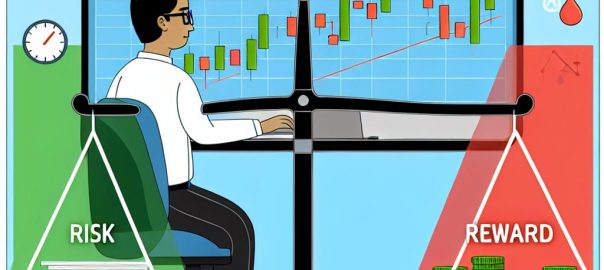How to Manage Risk When Trading Binary Options

Understanding Binary Options Trading
Binary options trading is a form of financial trading where participants make predictions about the price movement of an underlying asset within a specific time frame. The term “binary” is used because there are only two possible outcomes: the trader either receives a fixed return if the prediction is correct or loses the investment if it is not. This type of trading can be highly speculative and carries a set of inherent risks. Consequently, managing these risks effectively is essential for anyone looking to participate in binary options trading.
Key Risk Management Strategies
In the realm of binary options trading, it is imperative to employ effective risk management strategies. These strategies assist traders in protecting their investments and navigating the complexities of the market.
Use of a Reputable Broker
One of the first steps in managing risk is to ensure that you are working with a reputable and regulated broker. Engaging with a certified broker helps to avert scams and fraudulent activities. Traders should verify whether the broker is registered with recognized financial oversight bodies, such as the U.S. Commodity Futures Trading Commission (CFTC) or other equivalent organizations within their jurisdiction. A formidable broker will provide a secure trading atmosphere delivered through transparent practices.
Implementing a Sound Trading Plan
Another essential strategy is the implementation of a well-outlined trading plan. This plan should clearly detail your trading objectives, risk tolerance levels, and the strategies you will employ to enter and exit trades. Sticking to a predefined plan aids in maintaining discipline and reduces the likelihood of making impulsive decisions driven by emotions. It is prudent to develop this plan based on careful market research and analysis.
Understanding the Market and Instruments
Having a comprehensive understanding of the assets or markets you choose to engage with is critical before executing trades. This foundational knowledge enables traders to make informed predictions about future price movements. Following market trends, staying updated on news, and considering expert analyses can significantly enhance decision-making processes, providing a solid basis for your trading activities.
Financial Risk Management Techniques
In addition to general risk management practices, there are specific financial techniques that are particularly useful for managing risks in binary options trading.
Capital Allocation and Diversification
One fundamental financial strategy is prudent capital allocation and diversification. It is advisable not to commit all investment funds to a single trade. Instead, traders should allocate only a minor portion of their total investment portfolio to binary options. Diversifying trades across different assets can dissipate risk and potentially curtail losses, helping to stabilize investment outcomes.
Setting Stop-Loss and Take-Profit Limits
Even though traditional stop-loss orders do not directly apply to binary options due to their all-or-nothing nature, it is still valuable to define your acceptable loss in advance. Similarly, take-profit limits can assist in establishing preset points at which to exit profitable trades, thereby securing profits and reducing the risk of loss in the event of market reversals.
Position Sizing
Position sizing is another crucial consideration for risk management. This involves determining the size of your investment in accordance with your total capital and risk tolerance. Common guidance suggests risking no more than 2% of your capital on any single trade. Calculating the appropriate position size is essential to ensuring that your trading activities remain sustainable over the long term.
Psychological Aspects of Risk Management
Beyond financial strategies, the psychological aspects of trading have a substantial impact on managing risk effectively.
Emotional Control
Emotional control is vital in trading. Emotions like greed and fear can drive irrational trading behaviors, such as holding onto a losing position for too long or prematurely exiting a profitable trade. Exercising emotional discipline enables traders to commit to their strategies and make objective decisions, rather than succumbing to emotional impulses.
Continuous Learning and Improvement
A commitment to continuous learning and improvement is another psychological aspect that supports risk management. Traders should remain informed about developments in the trading world and engage in ongoing skill improvement activities. This includes reading industry publications, attending webinars, or participating in trading communities. Evaluating past trades and adjusting strategies as needed also contributes to a trader’s growth and risk management competence.
Evaluating the Use of Technology in Risk Management
The adoption of technological advancements can significantly augment traditional risk management methods within binary options trading.
Trading Software and Tools
Leveraging advanced trading platforms and software can provide a multitude of benefits. Features such as chart analysis, automated trading signals, and risk assessment tools offer insights that assist in automating parts of the trading process. By supplying critical data and analysis, these tools facilitate more strategic risk management actions and enhance overall trading efficacy.
Utilizing Data and Analytics
Utilizing data analytics forms another pillar of technological risk management. The analysis of historical data can uncover trends and patterns that inform more accurate predictions and trading decisions. Traders who leverage these analytics are better prepared to understand market dynamics and adjust strategies accordingly.
In summary, managing risk in binary options trading necessitates a multifaceted approach that incorporates diligent planning, effective financial strategies, psychological preparedness, and technological tools. By adhering to these comprehensive guidelines, traders can work towards mitigating risks and improving the likelihood of profitable outcomes in their trading endeavors.
This article was last updated on: April 10, 2025